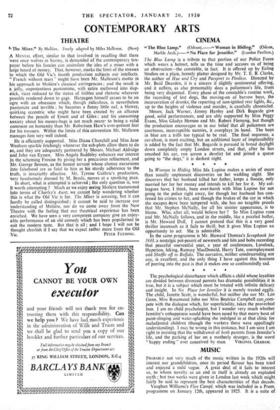CINEMA
it The Blue Lamp." (Odeon).----" Woman in Hiding." (Odeon, Marble Arch.)—" No Place for Jennifer." (London Pavilion.)
The Blue Lamp is a tribute to that portion of our Police Force which wears a helmet, tells us the time and accuses us of being an obstruction—the constable, in fact. It is offered up by Ealing Studios on a plain, homely platter designed by Mr. T. E. B. Clarke, the author of Hue and Cry and Passport to Pimlico. Directed by Mr. Basil Dearden, it is a sincere if slightly sentimental offering, and it suffers, as also presumably does a policeman's life, from being very disjointed. Every phase of the constable's routine work, the recording of lost dogs, the moving-on of barrow boys, the incarceration of drunks; the reporting of non-ignited rear lights, &c., up to the heights of violence and murder, is carefully chronicled.
Messrs. Jack Warner, -Jimmy Hanley and Dirk Bogarde give good, solid performances, and are ably supported by Miss Peggy Evans, Miss Gladys HenSon and Mr. Robert Flemyng, but though the production encourages us in our belief that all policemen are courteous, incorruptible nannies, it overplays its hand. The boys in blue are a trifle too typical to be real. The final sequence, a car-chase, is most exciting, but an additional layer of implausibility is added by the fact that Mr. Bogarde is pursued in broad daylight down completely empty London streets, and that, after he has smashed his car, run across a derelict lot and joined a queue going to "the dogs," it is darkest night.
* * * *
In Woman in Hiding Miss Ida Lupino makes a series of more than usually unpleasant discoveries on her wedding night. She discovers that her husband killed her father, keeps a floozie, only married her for her money and intends to kill her for it. My col- leagues have, I think, been over-harsh with Miss Lupino for not going to the police right away, for though her husband has con- fessed his crimes to her, and though the brakes of the car in which she escapes -have been tampered with, she has no tangible proofs that Mr. Stephen McNally, for all his sinister appearance, is to blame. Who, after all, would believe her ? So Miss Lupino runs and Mr. McNally follows, and in the middle, like a puzzled buffer, is Mr. Howard Duff. I cannot pretend that this is a very good thriller inasmuch as it fails to thrill, but it gives Miss Lupino an opportunity to act. She, is admirable.
In the same programme is Mr. Howard Thomas's Scrapbook for 1933, a nostalgic pot-pourri of newsreels and bits and bobs recording that peaceful uneventful year, a year of conferences, Lovelock, Hyperion, hiking, Ramsay MacDonald, Harry Tate, unemployment and Shuffle of to Buffalo.' The narrative, neither condescending nor coy, is excellent, and the only thing I have against this business of peering into the past is that it makes one so confoundedly sad.
The psychological disturbance which afflicts a child whose loyalties are divided between divorced parents has dramatic possibilities it is true, but it is a subject which must be treated with infinite delicacy and insight. In No Place for Jennifer it is merely treated eggily. The child, Janette Scott, is wonderful, but neither she nor Mr. Leo Genn, Miss Rosamund John nor Miss Beatrice Campbell can.com- pete with the dialogue which, for superficiality, takes the proverbial bun. I am no child psychologist, but I wonder very much whether Jennifer's unhappiness would have been eased by that merry bout of paint-slinging and water-splashing she indulged in at that clinic for maladjusted. children (though the workers there were appallingly understanding). I may be wrong in this instance, but I am sure I am right in insisting that the withdrawal of both parents from Jennifer's life, and the parking of her on a motherly stranger, is the worst
" happy ending " ever conceived by man. VIRGINIA GRAHAM.


































 Previous page
Previous page